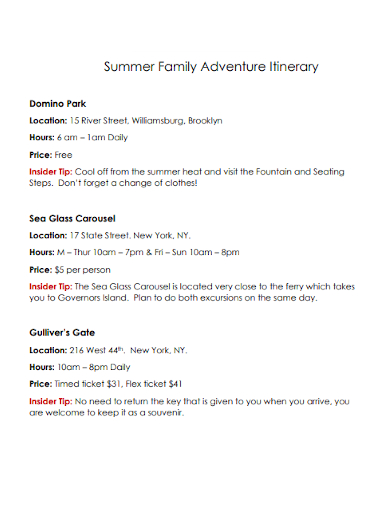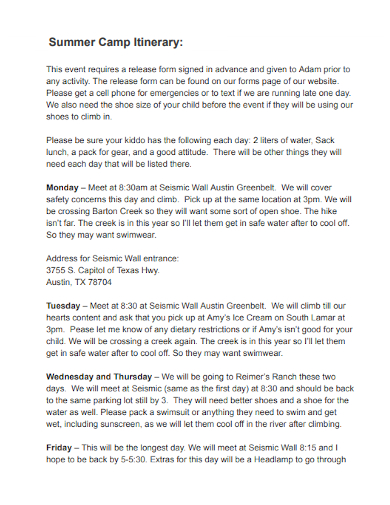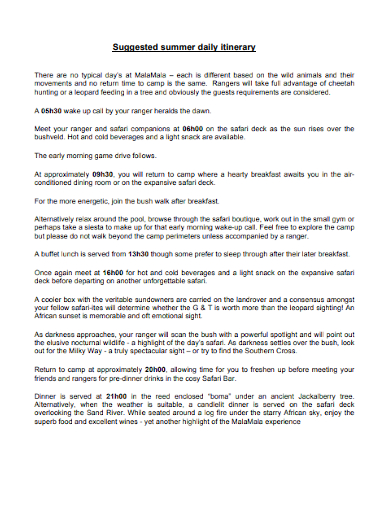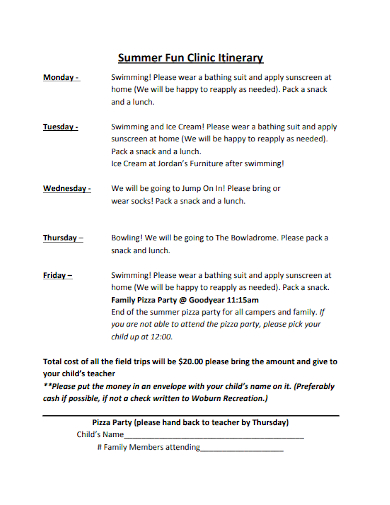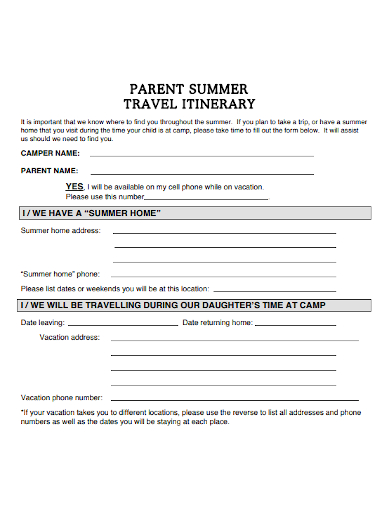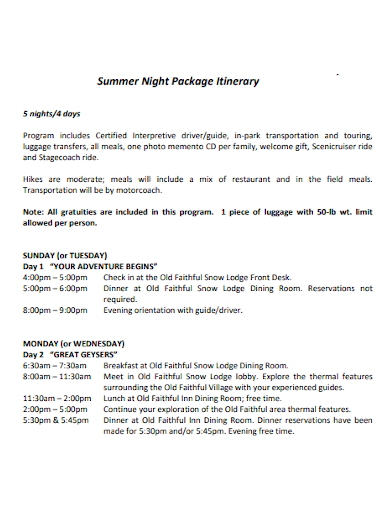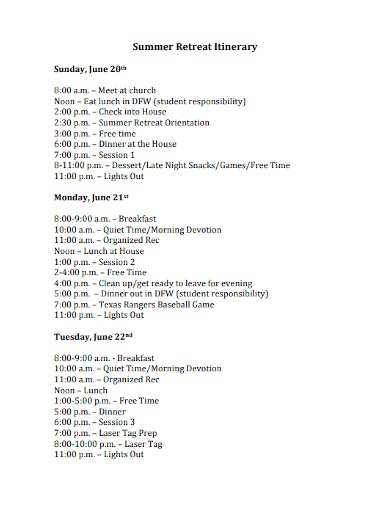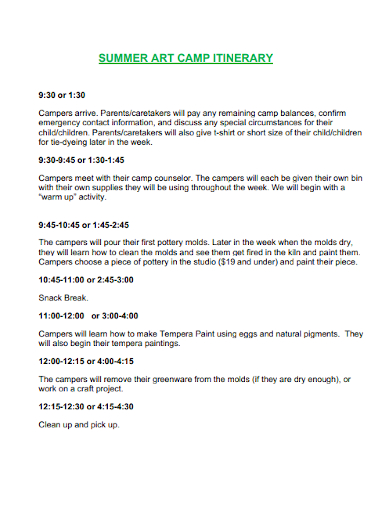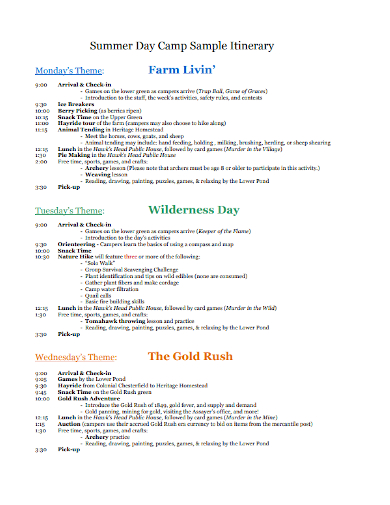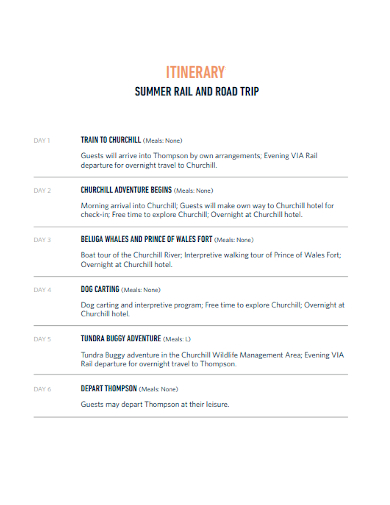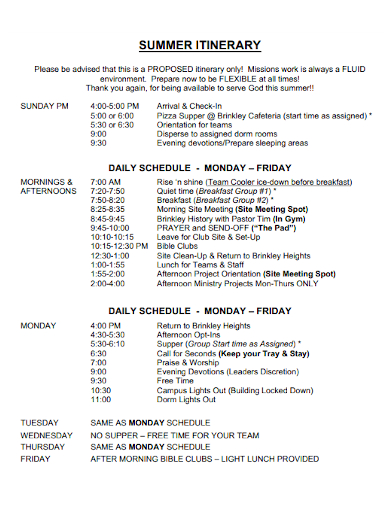Now that the strict travel restrictions due to the Covid-19 pandemic have been lifted, a lot of people are itching to travel to different places to finally have a proper vacation after being cooped up in their homes due to the social distancing practices. Tourist destinations are also opening their gates to the public so there is more interest by the people to travel to these places and unwind, relax, and have an adventure. Even though it’s not yet summer, it doesn’t hurt to plan your vacation if you badly want to travel somewhere. Planning for your trip will help you save money, decide which places you want to visit, and recruit friends or family members to join you on your trip. It’s best to create an itinerary to aid you in your planning. This article will guide you on how to make an itinerary for your summer vacation.
10+ Summer Itinerary Samples
1. Summer Family Adventure Itinerary
2. Summer Camp Itinerary
3. Suggested Summer Daily Itinerary
4. Summer Fun Clinic Itinerary
5. Parent Summer Travel Itinerary
6. Summer 5 Night Package Itinerary
7. Summer Retreat Itinerary
8. Summer Art Camp Itinerary
9. Summer Day Camp Sample Itinerary
10. Summer Rail & Road Trip Itinerary
11. Editable Summer Itinerary
How to Plan for a Summer Trip
1. Decide Where You Want To Go
Before you do all the planning for your summer vacation, the first thing to do is to decide where you would like to have your vacation. Knowing which place you’re going to gives a definite goal for your whole planning. Be specific on which places you plan to visit. For example, decide you’re going to Bali. Or you’re going to Orlando. It’s up to you where you want to go.
2. Decide the Length of Your Trip
Now that you’ve set your mind on your destination, it’s time to decide how long will you be staying there. If you decide ahead that you will be staying for two weeks or only three days in your destination will help you know how much money you need to save up for the trip.
3. Research Your Costs
So you know where you’re going and how long you’ll be staying there. Now it’s time to figure out exactly how much money you’re going to need for your trip. To do this, you need to research the cost of your destination and the style of travel you will be taking. You can use a guidebook, ask questions on community websites, or do a Google search for specific things such as food and activities you want to do. Once you’ve got the information you need, it’s time to save money. Write down all your current expenses so you can cut back on some of the unimportant things and save some for your trip.
4. Book Your Flight and Accommodation
Now that you’re finances are ready for your vacation, it’s time to book your flight and accommodation. Make sure to book weeks before your flight date and check-in date so you can save some money since there are usually discounts when you book early. You can surf the internet to look for websites where you can book hotels, hostels, beds, and breakfast for affordable rates. If you want to connect with more locals during your trip, you can join online platforms such as Couchsurfing or BeWelcome to stay in a house and save some money by having free accommodation.
5. Plan Your Activities
It’s best to outline all the major activities you want to try on your trip so you can budget your finances efficiently. Find out how much the activities cost. If you can, make reservations online for the tours and activities you want to do to ensure you have already booked those events. Sometimes you can even save some money since these reservations offer discounts. You can use your itinerary to list down the activities you’re going to do on your trip.
6. Pack Your Belongings
Now it’s time to pack for your trip. Remember that when you travel, pack light. It’s more liberating to be only bringing a few pieces of luggage so you don’t have the hassle to lug them around unless you’re going to a colder climate and you need to pack extra clothing. Only bring a few essential items for your trip. Remember to also bring some first aid and medicines in case you get sick.
How to Make an Itinerary
- Gather Your Travel Documents: Round up all the important documents, such as emails, tickets, brochures, pamphlets, notes, etc. needed for your upcoming trip. You also need to research some information regarding your destination and how to travel there.
- Use a Blank Document: A document in a Word processor, or a blank itinerary template is where you are going to write your itinerary. It’s up to you to write the itinerary by hand or use the digital word processor. Write first the name of your trip at the top of the itinerary document and list the start and end dates underneath it.
- Divide Your Itinerary Into Sections: To make the itinerary easy to understand and organized, you can format the itinerary into the following sections:
- General Information: This section contains the lodging, transportation, contacts, destinations to visit, etc. information.
- Dates/Times: This section is where you list the relevant dates and times of your trip, such as arrivals, departures, connections, reservation information, etc.
- Notes: This area is for any other information about your trip you should know about that doesn’t quite fall into the categories above.
FAQs
What are great summer vacation destinations in the USA?
There are a lot of beautiful places in the United States that are great summer destinations. The places listed below are the most popular vacation sites that tourists flock to every year.
- Yellowstone
- Chicago
- San Diego
- Glacier National Park
- Grand Canyon
- San Francisco
- Bar Harbor
- Miami
- Niagara Falls
What are the three types of itineraries?
The three types of itineraries:
-
One-way: You are traveling from your place of origin to another place without any plans of returning to your place of origin anytime soon.
-
Return or Round trip: You are traveling from your origin to your destination and then go back to your origin soon. Notice that
-
Open-jaw: Your travel does not only limit to flying in a plane but also includes a surface sector either by land or water either at your place of origin or the turnaround of your journey.
An itinerary is only as good as the information that is written in it. Double-check your itinerary to make sure you have included everything you need. You can ask someone else, especially someone who will be coming with you on your trip to review the itinerary just in case you forget to include some important information. This would also let them know all the information regarding the trip too. Make sure your notes are confirmed and accurate. Make sure the itinerary is written clearly and concisely. To help you get started writing the itinerary, download our free sample templates above to use as your guide!
Related Posts
Sample Business Card Templates
Sample Cashier Job Descriptions
Questionnaire Samples
FREE 10+ Sample HR Resource Templates in PDF
FREE 10+ HR Consulting Business Plan Samples in MS Word | Google Docs | Pages | PDF
FREE 49+ Sample Job Descriptions in PDF | MS Word
FREE 16+ Nonprofit Budget Samples in PDF | MS Word | Excel | Google Docs | Google Sheets | Numbers | Pages
FREE 13+ Academic Calendar Templates in Google Docs | MS Word | Pages | PDF
FREE 10+ How to Create an Executive Summary Samples in Google Docs | MS Word | Pages | PDF
FREE 23+ Sample Event Calendar Templates in PDF | MS Word | Google Docs | Apple Pages
Company Profile Samples
FREE 10+ Leadership Report Samples [ Development, Training, Camp ]
FREE 24+ Sample Payment Schedules in PDF | MS Word
FREE 10+ Return to Work Action Plan Samples in PDF | DOC
Autobiography Samples & Templates

